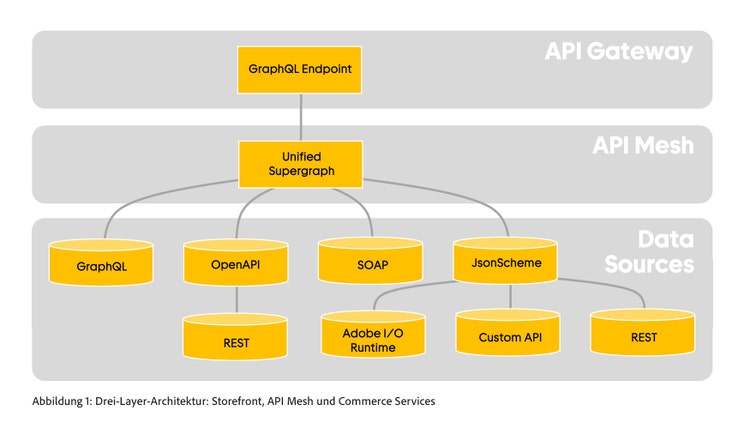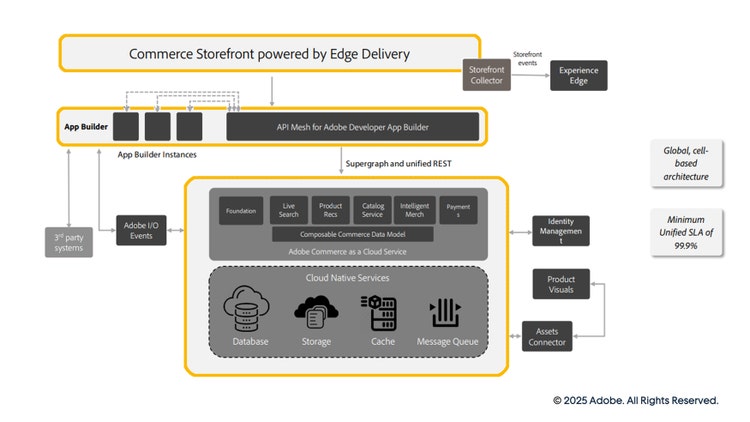Introduction
With the presentation of Adobe Commerce as a Cloud Service (SaaS) at the Adobe Summit 2025, Adobe is taking another logical step towards a modern cloud-native architecture. Adobe relies on scalable and proven cloud services for databases, storage, caching and message queues. The overall architecture is modular, open and extensible and follows an API-first approach. This allows third-party integrations and individual extensions to be implemented more flexible.

The overall architecture is divided into three levels:
- Commerce Storefront - Guarantees a high-performance storefront delivery based on Edge Delivery Services (EDS).
- API Mesh Layer - Provides a unified GraphQL interface to aggregate Adobe and third-party APIs based on the App Builder platform and running on Cloudflare Workers.
- Adobe Commerce Services - Cloud-native services for scalable commerce applications running on a cell-based architecture.
This architecture ensures high scalability, availability and performance in many commerce use cases. Let's take a closer look at the individual components below.
Commerce Storefront
Scalable and high-performance front-end solutions via Edge Delivery Services
There has been a significant change in the storefront compared to the familiar Adobe Commerce architecture. The commerce storefront is now implemented and delivered via the edge delivery services familiar from Adobe Experience Manager (AEM). The storefront content is delivered directly via a Content Delivery Network (CDN) “on the edge” to ensure particularly fast and scalable delivery.
Inside the central delivery layer of the Edge Delivery Services, there is a clear separation of the storefront content. This delivery layer is made up as follows:
- Content Bus
Management of structured and unstructured content in the form of simple structured markup
- Config Bus
Management of the storefront's own configurations, such as CDN configuration
- Code Bus
Management of storefront-specific frontend code resources such as JavaScript and CSS
- Media Bus
Management of image content
Building on this, all elements use cloud-native S3 storage and content delivery networks to ensure that all content is delivered with high availability and performance.
Commerce Drop-Ins
The integration of commerce functionalities in the storefront takes place via so-called drop-in components. Drop-ins are fully implemented shopping components in JavaScript that transform a website into a storefront. The ready-to-use components are not simple content blocks such as carousels or galleries, but offer a complete implementation of online shopping functionalities - including product detail pages and other commerce functions such as a shopping cart. These drop-ins can be very easily integrated into the existing front-end implementation of Edge Delivery Services. Adobe provides a so-called boilerplate implementation for this, which acts as a kind of template, see https://github.com/hlxsites/aem-boilerplate-commerce
Content-Authoring
Adjustments to the content of the storefronts are made analogous to the options of the AEM Edge Delivery Services. Adobe distinguishes between the following options:
- Storefront Builder
WYSIWYG Editor, probably similar or identical to the Universal Editor known from AEM - Document-based Authoring
Content is created and managed via Microsoft Word or Google Docs including the integration of Microsoft SharePoint or Google Drive
API Mesh Layer
Adobe Commerce as a cloud service relies on an API-first approach with an API mesh layer. The API mesh layer forms a supergraph. This supergraph is a standardized, composite GraphQL schema that consists of several individual subgraphs (sub-schemas). It provides a central API to the outside world - effectively the “single source of truth” for all connected data sources and services.
A Federated Data Access Layer (FDAL) is the underlying architecture or technical layer that makes it possible to connect these individual subgraphs with each other and orchestrate them at runtime. It ensures that:
- requests are split up and forwarded to the correct data sources,
- the results are combined and returned as one answer,
- authentication, caching, routing etc. can be managed centrally.

Extensibility via App Builder and Adobe I/O Events
Due to the API-first architecture, the API Mesh Layer is also the central point for custom extensions. Extensions are made via Adobe Developer App Builder. App Builder is a serverless extension platform for the integration and development of individual experiences with which the functions of Adobe Commerce can be specifically extended.
Developers can use it to create their own services, extend central commerce functionalities and link Adobe Commerce with other Adobe solutions as well as with third-party systems. Via Adobe I/O Events, it is possible to react to events in the central Adobe Commerce services at this level almost in real time.
Serverless Architecture with Cloudflare Workers
The API Mesh Layer is based on Cloudflare Workers and uses a V8 Isolate architecture for serverless processing of API requests. This architecture enables:
- Dynamic scaling through rapid provision of new instances without cold start problems.
- Load balancing across a global network of over 335 data centers, allowing API queries to be processed efficiently.
- Low latency times, as requests are executed as close as possible to the end user.
This architecture ensures high availability and performance for commerce and content data, regardless of the number of connected services and data sources.
Adobe Commerce Services
Adobe Commerce Services are based on a cell-based architecture in which the system is divided into several independent cells (services). This architecture enables a scalable, highly available and high-performance infrastructure. The cells run on Adobe's container-based orchestration platform and scale dynamically via horizontal pod autoscaling. They can also be replicated globally between different data centers. This means that the cells can be provided from different regions around the world. Intelligent routing ensures that requests are always routed to the closest and most powerful cell, guaranteeing high availability and low latency.
Important Commerce Cells (Services)
- Commerce Foundation
The Commerce Foundation is a multi-tenant PHP application that acts as a central service for Adobe Commerce. It uses cloud-managed databases for scalable and fail-safe storage and cloud-managed message queues for efficient processing of asynchronous processes. This architecture enables flexible scaling and high availability.
- Live Search
The Live Search Service bundles the search functions in the storefront via a dedicated GraphQL endpoint. Administrators can use this service to set up, customize and manage search facets (masks), synonyms and merchandising rules. Intelligent processes supported by Adobe Sensei are also used to determine search results, e.g. for sorting search results. Technically, this service is closely linked to the Catalog Service.
- Product Recommendations
The Product Recommendations Service enables the product recommendations displayed in the storefront to be encapsulated. Based on intelligent algorithms, the aggregated visitor data is analyzed and combined with the data from the product catalog to generate personalized product recommendations. Different types of product recommendations can be combined in the same storefront. These are managed in the commerce backend via a dedicated administration interface including dashboards and reporting.
- Catalog Service
The Catalog Service uses the Composable Catalog Data Model, which enables flexible mapping of different store structures in channels - for different brands, regions or customer groups, for example. Individual channels are configured using reusable components:
- Policies define data filters that can be used to display products specifically for each channel
- Locals ensure language localization
- Price Books enable different price structures for each channel
Despite this flexibility, the system is based on a uniform, centrally maintained product catalog. This reduces redundancy and simplifies maintenance.
- Payments
Payment Services for Adobe Commerce as a Cloud Service (SaaS) is a complete self-service solution - including sandbox testing and easy setup - to provide powerful and secure payment processing for the commerce storefront.
Product Visuals
The technology behind the name Product Visuals is an AEM Assets as a Cloud Service installation. This is now closely linked to the Commerce Services backend and enables near real-time editing of product images.
In addition, the use of AEM assets in the cloud for the management, editing and creation of product images provides a range of new services, such as the use of Adobe Express or Adobe Firefly for the rapid editing of images.
Summary
In terms of technology, Adobe has taken a further step towards a modern and scalable cloud architecture with the new commerce architecture. The introduction of Edge Delivery Services is expected to significantly enhance the Storefront's delivery capabilities and overall performance. A process that needs to be monitored. The way in which extensions and adjustments are made will also change fundamentally with the new architecture.
eggs unimedia supports you in understanding and immersing yourself in this new architecture.
